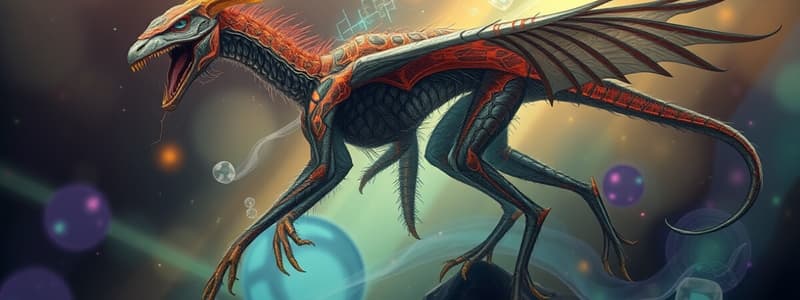Podcast
Questions and Answers
Who is the man responsible for the first modern system of classification?
Who is the man responsible for the first modern system of classification?
Carolus Linnaeus
Who was the first man to attempt to classify living organisms?
Who was the first man to attempt to classify living organisms?
Aristotle
A system of naming in which the organism is assigned a two-part name is called?
A system of naming in which the organism is assigned a two-part name is called?
binomial nomenclature
What is the name of a classification key in which there are always two choices?
What is the name of a classification key in which there are always two choices?
The science of identification and classification is called?
The science of identification and classification is called?
A group of living organisms that can interbreed and produce fertile offspring is called a?
A group of living organisms that can interbreed and produce fertile offspring is called a?
The first subdivision of a kingdom is?
The first subdivision of a kingdom is?
In what language are all scientific names written?
In what language are all scientific names written?
The term given to two structures that are similar in function but unrelated in structure is?
The term given to two structures that are similar in function but unrelated in structure is?
List the levels of classification.
List the levels of classification.
What name is given to two structures that are similar in structure but have different functions?
What name is given to two structures that are similar in structure but have different functions?
_________ are essentially super kingdoms; a taxonomic level even higher than the kingdom level.
_________ are essentially super kingdoms; a taxonomic level even higher than the kingdom level.
What name is given to a structure that is reduced in size and seems to be left over from a previous ancestor?
What name is given to a structure that is reduced in size and seems to be left over from a previous ancestor?
Into what three groups did Aristotle divide all animals?
Into what three groups did Aristotle divide all animals?
Into what three groups did Aristotle divide all plants?
Into what three groups did Aristotle divide all plants?
The first word of a scientific name is the ___ and the second word in a scientific name is the ___.
The first word of a scientific name is the ___ and the second word in a scientific name is the ___.
The organisms in the animal kingdom are further subdivided into ___, but the organisms in the plant kingdom are further subdivided into ___.
The organisms in the animal kingdom are further subdivided into ___, but the organisms in the plant kingdom are further subdivided into ___.
List the domains of the three-domain system.
List the domains of the three-domain system.
Term meaning that an organism does not contain a nucleus or any membrane-bound organelles.
Term meaning that an organism does not contain a nucleus or any membrane-bound organelles.
What characteristic is shared by all members?
What characteristic is shared by all members?
List the four kingdoms belonging to the domain eukarya.
List the four kingdoms belonging to the domain eukarya.
Estimating the length of time that two species have been separate from one another using differences in their DNA and the proteins being built is known as?
Estimating the length of time that two species have been separate from one another using differences in their DNA and the proteins being built is known as?
The organisms on Earth are constantly evolving and changing. Those best suited are more likely to survive, reproduce, and pass these favorable genes on to their offspring. This concept is known as ___.
The organisms on Earth are constantly evolving and changing. Those best suited are more likely to survive, reproduce, and pass these favorable genes on to their offspring. This concept is known as ___.
In the first scientific classification of living things, organisms were classified according to:
In the first scientific classification of living things, organisms were classified according to:
The taxonomic category that includes the greatest diversity of organisms within a given kingdom is the:
The taxonomic category that includes the greatest diversity of organisms within a given kingdom is the:
You would expect to find larger numbers of organisms in a family than in a:
You would expect to find larger numbers of organisms in a family than in a:
The basis for the former two-kingdom system was classification of organisms as to whether they were:
The basis for the former two-kingdom system was classification of organisms as to whether they were:
As we proceed down the classification table from kingdom to species, there is an increase in:
As we proceed down the classification table from kingdom to species, there is an increase in:
In order to place a newly identified species into one of the three domains, the first piece of information you would need to know is:
In order to place a newly identified species into one of the three domains, the first piece of information you would need to know is:
According to the six-kingdom classification system, how many kingdoms are represented in the following list of organisms: ferns, jellyfish, clams, molds, mushrooms, conifers, true bacteria, algae and starfish?
According to the six-kingdom classification system, how many kingdoms are represented in the following list of organisms: ferns, jellyfish, clams, molds, mushrooms, conifers, true bacteria, algae and starfish?
As you move down the levels of classification from the kingdom to the species, the organisms:
As you move down the levels of classification from the kingdom to the species, the organisms:
Man's scientific name is Homo sapiens. 'Homo' describes man's:
Man's scientific name is Homo sapiens. 'Homo' describes man's:
Flashcards are hidden until you start studying
Study Notes
Classification and Taxonomy
- Carolus Linnaeus developed the first modern classification system, using binomial nomenclature for naming organisms.
- Aristotle was the first to categorize living organisms into groups based on observable characteristics.
- Taxonomy is the science dedicated to the identification and classification of organisms.
Naming and Classification Systems
- Binomial nomenclature assigns organisms a two-part scientific name: the first part indicates the genus, and the second identifies the species.
- A dichotomous key is a classification tool that allows organisms to be identified based on a series of choices.
Hierarchy of Classification
- The seven levels of classification are: kingdom, phylum, class, order, family, genus, and species.
- The first subdivision of a kingdom is called a phylum.
- Domains are super kingdoms that categorize life into broader groups than kingdoms.
Characteristics of Organisms
- Species are groups of organisms that can interbreed and produce fertile offspring.
- Prokaryotic organisms lack a nucleus and membrane-bound organelles.
- Eukaryotic organisms, which have a nucleus, are divided into four kingdoms: Plantae, Animalia, Fungi, and Protista.
Evolution and Adaptation
- Natural selection is the process by which organisms best adapted to their environment survive and reproduce.
- Molecular clocks estimate the time species have evolved apart, based on genetic differences.
Aristotle's Classification
- Aristotle divided animals into categories: land, water, and air dwellers.
- He categorized plants into herbs, shrubs, and trees.
Structures and Features
- Homologous structures have similar forms but different functions, while analogous structures have similar functions but different forms.
- Vestigial structures are reduced in size and remnants of ancestral features.
Classification Trends
- With increased taxonomic levels, organisms display greater structural similarities.
- Larger numbers of organisms are found within a family compared to a genus.
Additional Classification Concepts
- The six-kingdom classification includes multiple groups based on structural similarities.
- The presence or absence of a nuclear membrane is crucial for placing species in the correct domain.
Conclusion
- Understanding taxonomy and classification helps in studying biodiversity and evolutionary relationships among organisms.
Studying That Suits You
Use AI to generate personalized quizzes and flashcards to suit your learning preferences.




